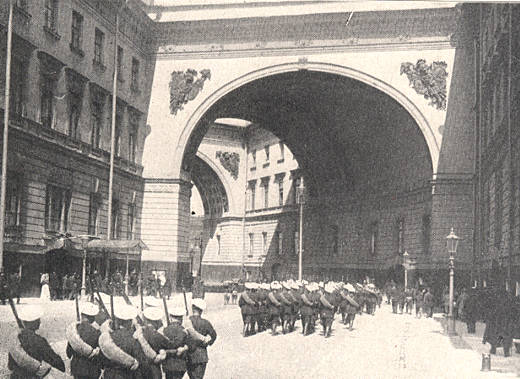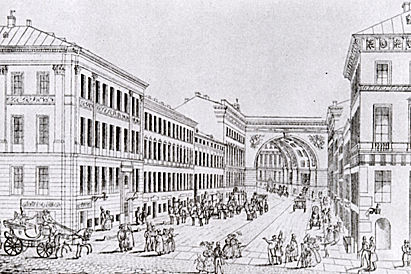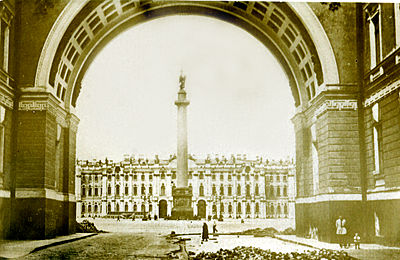   

Here we see the Great Morskaya Street, which until the end of the 19th century was paved with wood. This short street leads through an arch into palace Square. All of the pictures at the top of these pages come from the 1914 edition of the Burton Holmes Travelogues. Mr. Holmes and his team of photographers visited both St. Petersburg and Moscow in 1900. troops marching turn up in several of his pictures around the Winter Palace. It appears Mr. Holmes must have arranged for the soldiers to add color to his photographs and had them parading about as his men took these candid shots.  Above: The Great Morskaya - a drawing from the 1830's.
The famous composer Tchaikovsky lived in a building on the right hand side of Great Morskaya Street. Although this is the very center of Petersburg people of all classes lived here at the heart of the city. Almost everybody rented or leased their living accommodations, even the aristocracy. Housing in Petersburg in 1900 was expensive and in short supply. Modernization meant that 90% of all apartments of three rooms or more had electricity and indoor plumbing. Unfortunately, 33% of Petersburgers lived in apartments smaller than three rooms and only 24% of these had indoor plumbing at the turn of the century. Things were pretty crowded with the average apartment holding 7 people in 1900. 1900 Generally the bottom floor of buildings was given over to shops. The second floor was usually the most expensive and it was here that the aristocracy lived. Above them prices for apartments and flats decreased the higher you went, while the basement was the cheapest.
A 19th century visitor to St. Petersburg noted:
"I knew of one [building] of which the ground-floor, on one side, was occupied by a public bazzar, in which thousands of the necessaries of conveniences of life were offered for sale. On the other side, a multitude of German, English, and French mechanics and tradesmen had hung their signs. On the first floor dwelt two senators, and the families of various other persons of distinction. On the second floor was a school of very high repute, and a host of academicians, teachers, and professors, dwelt there with their families. In the back of the building, not to talk of a multitude of obscure personages, there resided several colonels and majors, a few retired generals, an Armenian priest and a German pastor. Had all the rest of Petersburg gone to the ground, and this house alone remained, its inhabitants would have sufficed for the formation of a little political community of their own, in which every rank in society would have had it's representatives."
Servants in Petersburg were very inexpensive to hire and even the lower middle classes had at least one or two to help with household responsibilities. Live-in servants usually slept wherever they could, with kitchen staff bedded down at night near the oven.  Above: View though the Great Morskaya arch into Palace Square.
The most privileged servants in Russian domestic service were valets and maids. A Tsar's valet earned the equivalent of around $275 a month, which was a lot of money in those days. In Russian tradition a maid often slept in the same room as the lady she served. A maid cost $2.50 a month in 1900 or the equivalent of around $50.00 a month today; her lodgings and food were included. A good maid was hard to find for she had to be discrete, quiet and yet a good companion when needed, clean and attentive, chaste and handy at dozens of small things for her lady. She could have few aspirations for her own life and a husband or boy friend was out of the question.
Next photograph: The Nevsky Prospect
For a small map of the St. Petersburg area click here.
To see a large map of the center
of St. Petersburg go here.
Comments on the website should be sent to Bob
Atchison. |
 |
|

